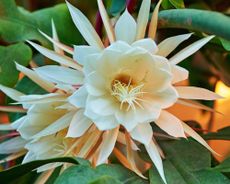Purple Dragon Carrot Growing

Carrots seem to be the one vegetable that are accepted by pretty much everyone, including me. These sweet root veggies tempt the pickiest child and the diehard carnivore. Carrots are available in a slew of colors that add to their lure at the dinner table, but are not likely to be found outside the farmers market, or your own garden plot. One of these colorful varieties is the heirloom Dragon carrot. Don't let the name shy you away from this delectable snack, though. There's more to this vegetable than one might think.
Dragon Carrot History
Carrots (Daucus carota), in general, have a long-standing history. Domestic carrots, available in purple, red and white, originated in Afghanistan while yellow carrots have their roots set in Turkey in the 900's. The Dutch developed the commonly identifiable orange carrot in the 1600's. Bet you didn't know its history went back so far, huh? The French seedhouse, Vilmorin-Andriueux, is responsible for the development in the late 1880's of most of the varieties found today. Carrot varieties fall into one of the following five categories: Nantes, Chantenay, Miniature, Imperator and Danvers, of which the heirloom Dragon carrot is a member. Dragon carrots are a purple variety of carrot, (Yes, I did say purple) at least on the outside. Inside the carrot is a contrasting yellow-orange that is quite spectacular when sliced. Purple carrots were grown by the ancient Egyptians and Romans as well as the Chinese, but this varietal was bred by John Navazio and is a very recent introduction to the heirloom world - most probably related to the Cosmic Purple carrot. A member of the Daucus genus, Purple Dragon carrots, sometimes called Red Dragon, are an open-pollinated varietal. Another interesting nugget amongst Dragon carrot history; it has the same amount of lycopene and antioxidants as tomatoes. Their flavor is sweet as with most carrots, but with a hint of spiciness as well. Could it be this spiciness that gives the veggie its dragon name? Perhaps. Got the ole wheels a turning at any rate.
Purple Dragon Carrot Growing
Purple Dragon carrots are propagated via seed, which can be obtained from most heirloom seed suppliers. As with other carrot types, Purple Dragon carrot growing is most successful in sandy or loamy type soil that is weakly acidic. Heavy, clay laden soils may cause twisted, deformed roots and generally affect the size of the carrot, which should be between 6-8 inches in length. Purple Dragon carrots are considered to be very hardy and tend to do best in cooler northern regions, like mine. Sow seed indoors 3-4 weeks before the last frost or directly outside in full sun once soil temps are above 60 degrees F. (15 C.) and keep moist. Germination takes some time, so be patient. Trust me, it's gonna be well worth the wait! Thin to 2-3 inches apart. Harvesting will begin in the late spring.
Gardening tips, videos, info and more delivered right to your inbox!
Sign up for the Gardening Know How newsletter today and receive a free download of our most popular eBook "How to Grow Delicious Tomatoes."

Amy Grant has been gardening for 30 years and writing for 15. A professional chef and caterer, Amy's area of expertise is culinary gardening.
-
 7 Best Dwarf Tomato Plants
7 Best Dwarf Tomato PlantsHave a tiny growing space? Look for dwarf tomato seeds so you don’t miss out on summer’s juicy bounty.
By Susan Albert
-
 5 Night-Blooming Houseplants – Grow An Indoor Moon Garden
5 Night-Blooming Houseplants – Grow An Indoor Moon GardenThere is something uniquely special about night-blooming houseplants. Set the scene for a magical evening indoors with these fragrant flowering beauties.
By Amy Grant